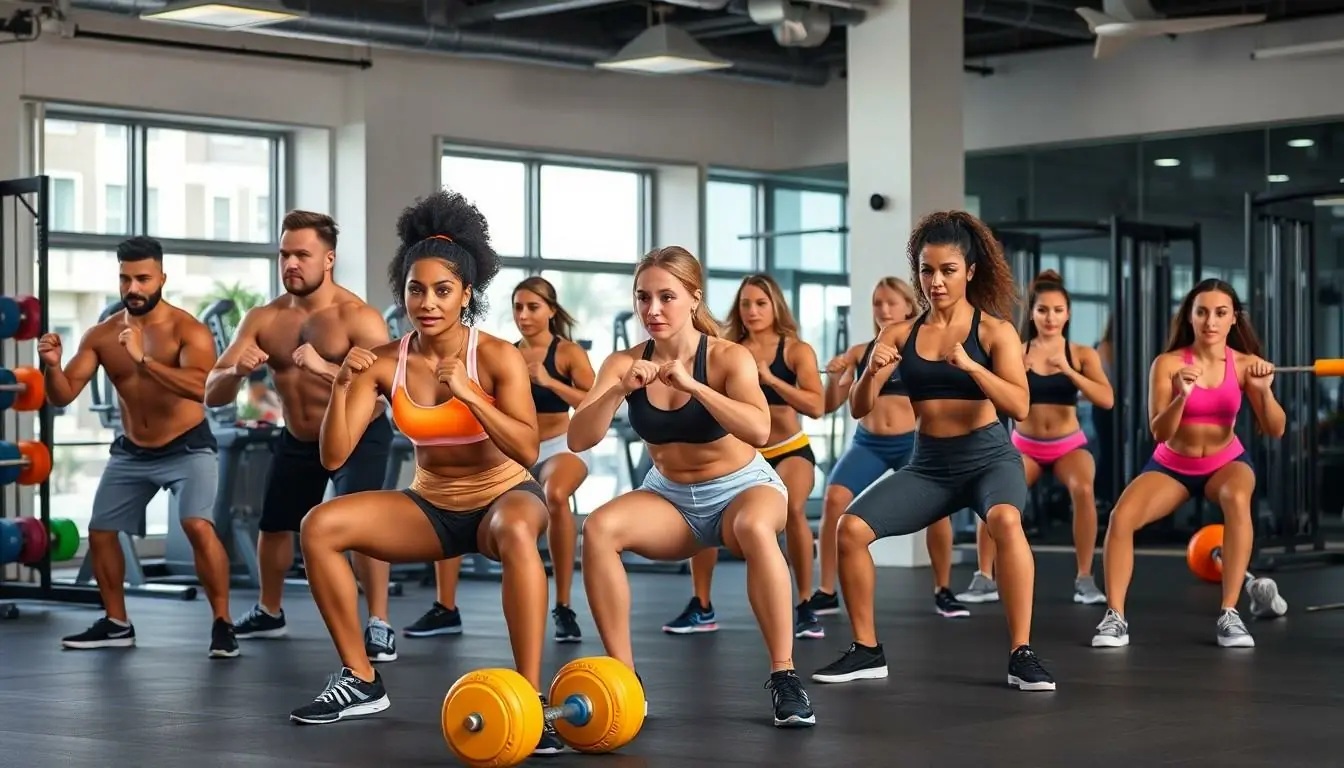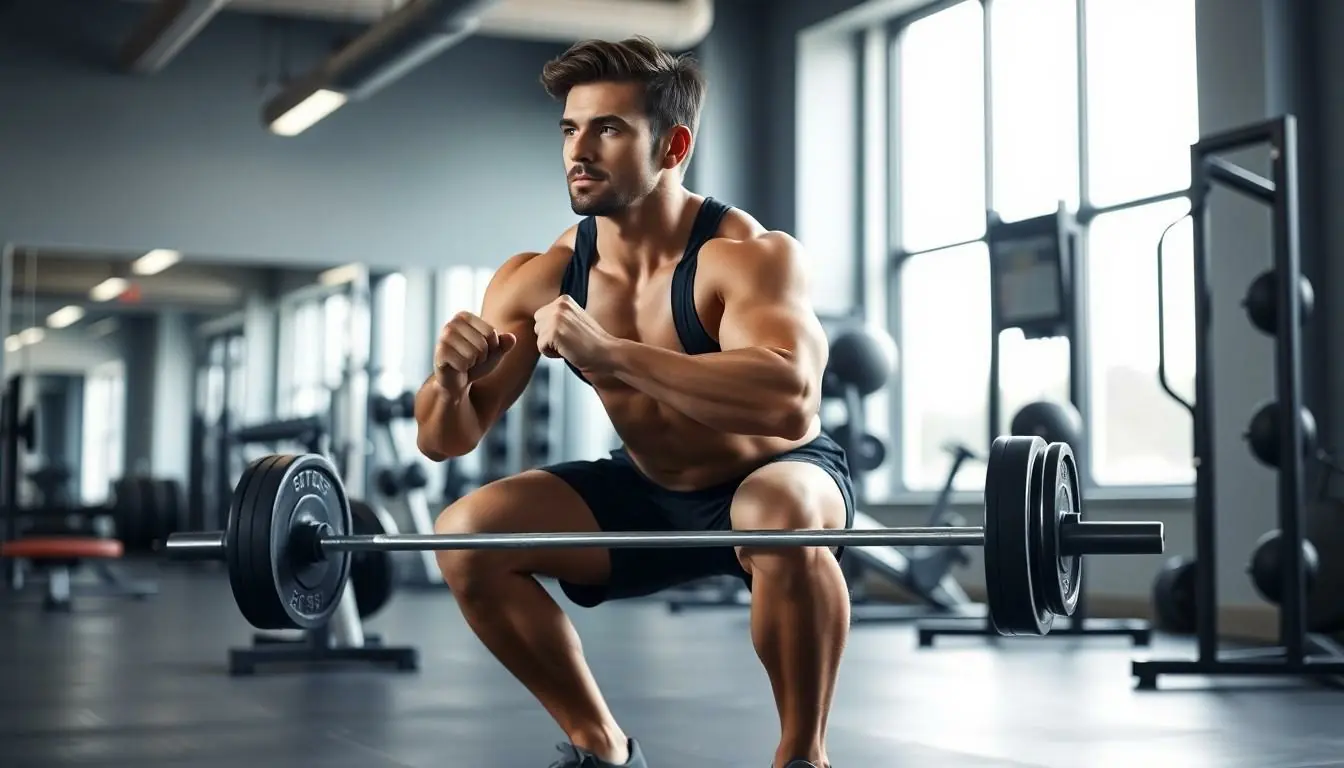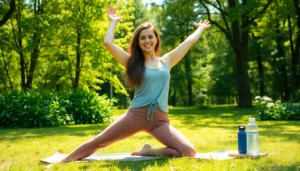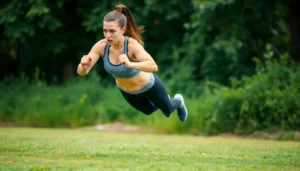Table of Contents
ToggleLeg day is often the most dreaded part of the gym routine, but it doesn’t have to be a grueling affair. In fact, a well-structured leg gym workout can be as exhilarating as a roller coaster ride—minus the screaming and nausea. From squats that make you feel like a superhero to lunges that challenge your balance like a tightrope walker, leg workouts are the secret sauce to building strength and endurance.
Overview of Leg Gym Workout
Leg gym workouts serve as a crucial component of any fitness regimen. These sessions target major muscle groups, including quadriceps, hamstrings, glutes, and calves. Effective leg workouts enhance overall strength and support athletic performance.
Squats stand out as fundamental exercises, activating multiple muscles simultaneously. Variations like front squats or goblet squats cater to different fitness levels. Lunges also play an essential role, allowing for single-leg stability and balance improvement.
Incorporating deadlifts contributes to muscle growth in the posterior chain. This exercise engages the lower back, hamstrings, and glutes, promoting strength and mobility. Additionally, leg presses offer a controlled alternative that isolates leg muscles effectively.
Calf raises add definition and strength to the lower legs. With variations such as seated and standing calf raises, individuals can target different parts of the calf muscles. Furthermore, including leg extensions and hamstring curls isolates specific muscle groups for targeted development.
A well-rounded leg workout typically combines compound and isolation exercises. This approach maximizes muscle activation while minimizing the risk of injury. An effective strategy involves high repetition ranges (12-15 reps) paired with moderate weights for endurance training.
Overall, consistency in leg gym workouts fosters physical transformation. Progress tracking contributes to sustained motivation and empowers individuals to reach their fitness goals.
Benefits of Leg Gym Workouts

Leg workouts provide numerous advantages for overall fitness and health. They play a vital role in strengthening lower body muscles, laying the foundation for various physical activities.
Improved Strength and Endurance
Strength and endurance improve significantly through consistent leg workouts. Squats and lunges target major muscles, enhancing muscle performance during exercises. Regular training builds strength in quadriceps, hamstrings, glutes, and calves. Increased muscular endurance enables individuals to perform daily activities with less fatigue. Engaging in higher repetition ranges with moderate weights boosts stamina, allowing athletes to push through longer workouts. Resistance training promotes hypertrophy, which translates to better performance in numerous exercises. Active engagement in leg workouts leads to increased bone density, reducing the risk of osteoporosis. Overall, stronger legs provide enhanced stability and support for the entire body.
Enhanced Athletic Performance
Athletic performance enhances notably with focused leg workouts. Exercises like squats improve explosive power, critical for various sports. Leg strength contributes to better sprinting speed, jumping ability, and agility on the field or court. Strengthening lower body muscles improves overall coordination and balance, essential for athletic endeavors. Improved endurance leads to reduced fatigue during intense training sessions and competitions. Incorporating deadlifts and leg presses specifically targets fast-twitch muscle fibers, crucial for power generation. Additionally, stronger legs facilitate faster recovery times, enabling athletes to train more frequently and effectively. Consequently, well-developed leg muscles lay the foundation for achieving peak performance across multiple activities.
Essential Leg Exercises
A variety of exercises enhance leg workouts, contributing to overall strength and performance. Two fundamental exercises include squats and lunges, both vital for targeting major leg muscle groups.
Squats
Squats serve as a cornerstone in leg workouts, engaging quadriceps, hamstrings, glutes, and core muscles. Variations such as front squats and goblet squats accommodate different fitness levels, making them accessible for all. Proper technique emphasizes depth in the squat to maximize muscle activation, while keeping knees aligned with toes to prevent injury. According to fitness experts, incorporating squats into workouts promotes balance and stability, essential for athletic activities. Additionally, high repetition ranges with moderate weights foster endurance, offering effective training for both novice and experienced gym-goers.
Lunges
Lunges focus on improving single-leg stability and balance, essential components of lower body strength. They target similar muscle groups as squats, particularly the quadriceps, hamstrings, and glutes, ensuring a comprehensive leg workout. Forward lunges and reverse lunges offer variety, allowing for a dynamic range of movement. Engaging the core during lunges enhances overall body stability. Fitness studies indicate lunges also stimulate functional strength, beneficial for various physical activities. For optimal results, performing lunges in multiple directions, such as lateral or curtsy lunges, contributes to better agility and coordination.
Sample Leg Gym Workout Routine
A well-balanced leg workout routine boosts strength and endurance, accommodating varying fitness levels.
Beginner Routine
Start with bodyweight squats, completing 3 sets of 10 to 15 reps to establish proper form. Follow with lunges, performing 3 sets of 8 to 10 reps per leg, focusing on maintaining balance. Next, leg presses offer an excellent way to build muscle; 3 sets of 10 to 12 reps work effectively for beginners. Finish with calf raises, completing 3 sets of 12 to 15 reps to enhance lower leg strength. Incorporating a brief warm-up and cool-down will enhance performance and aid recovery.
Advanced Routine
Incorporate barbell squats into the routine for enforced strength; 4 sets of 6 to 8 reps provide an excellent challenge. Include Bulgarian split squats, performing 3 sets of 8 to 10 reps per leg to target stability and balance further. Deadlifts promote muscle growth in the posterior chain; 4 sets of 6 to 8 reps effectively develop strength. Finally, plyometric calf raises encourage explosive power; 3 sets of 10 to 12 reps add athletic value. Ensure progressive overload to track improvements and motivate continued growth.
Tips for Effective Leg Workouts
Ensuring proper warm-up is vital before starting leg workouts. This process increases blood flow to muscles, preparing the body for intense exercises. Incorporating dynamic stretches helps improve flexibility and reduces injury risk.
Prioritizing form over weight leads to better results. Maintaining proper alignment during squats and lunges maximizes muscle activation while minimizing strain. Engaging the core stabilizes the body, further enhancing effectiveness.
Incorporating variety keeps leg workouts interesting and effective. Alternate between compound exercises like squats and isolation exercises such as leg extensions. This variation not only targets different muscle groups but also prevents workout monotony.
Monitoring workout intensity is crucial for progress. Using progressive overload, gradually increase weights and repetitions to challenge the muscles. Aiming for high repetitions with moderate weights builds endurance effectively.
It’s beneficial to schedule leg workouts regularly. Committing to a routine fosters consistency, which is key to physical transformation. Pairing leg days with adequate rest periods supports muscle recovery and growth.
Hydration plays a significant role in optimizing performance. Drinking water before, during, and after workouts helps maintain energy levels and promotes recovery. Staying hydrated ensures muscles function efficiently and reduces fatigue.
Setting specific goals enhances motivation during leg workouts. Establishing clear, achievable targets, such as increasing squat weight or completing more repetitions, drives progress. Tracking these goals helps individuals visualize their improvements over time.
Leg workouts are essential for anyone looking to enhance their overall fitness and athletic performance. By embracing a structured routine that includes exercises like squats and lunges, individuals can experience the thrill of progress and empowerment.
The benefits extend beyond mere strength building; improved coordination, balance, and endurance contribute to better daily functioning and athletic capabilities. With proper technique and a focus on variety, leg day can transform from a dreaded chore into an exciting challenge.
Consistency is key, and incorporating both beginner and advanced routines ensures that everyone can find their path to success. With dedication and the right approach, leg workouts will not only foster physical transformation but also inspire a lifelong commitment to fitness.




